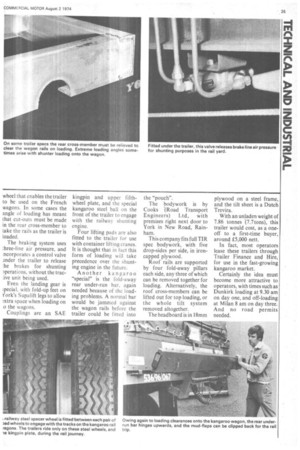Kangaroo production
Page 26

Page 27

If you've noticed an error in this article please click here to report it so we can fix it.
leaps ahead by Jerry Rodwell THE RAINHAM plant of York Trailers is now well ahead on production of kangaroo trailers for use on the French SNCF rail System.
Latest order, 140 for Trailer Financing and Hire Ltd, includes this country's first widespread bogie kangaroos.
Designed to run abroad at 33 tonnes (32.5 tons) gross trailer weight, these kangaroos incorporate many special features both in basic design and in construction for very heavyduty work.
The specification was decided by Novatrans (Europe) Ltd, of Eastcheap, London, the company running the kangaroo service.
The trailers are 12m (40ft) by 2.4m (8ft) as usual, but have cut-off top corners to enable them to pass safely under tunnels and other obstructions in France when mounted on the special kangaroo rail wagons.
Little space lost But owing to the use of very shallow sections for the neck of the trailer, the resulting loss in cubic feet from the corner cut-offs, is nearly neutralized by the gain through a lower floor level. In fact, the trailer capacity is only some 0.5 cum (20 cu ft) less than a normal TIR trailer.
The shallow neck is achieved by the use of four I'-beam sections between the trailer front and the leg support area, instead of the normal two main beams. Beam section is 457mm x I52mm, with cross-members of 102mm x 51mm rolled steel channel at 600mm centres, along with extra strengthening and strapping.
All this additional strengthening is needed because very high stresses are imposed on the frame when the trailer is lifted by the special kangaroo ball hitch at the front.
With the trailer assuming angles of as much as 3( degrees as it drops into th( rail wagon "pouch", stresset and racking of the frame car reach very high values in tht neck area.
This kind of angle of tilt trailer has also necessitate( the design of a suspensiot with high oscillation pro perties.
York uses widespread sus pension with eight-leaf semi elliptic springs and Ruber: Owen metric axles. Betweei each pair of wheels i mounted the steel railwa wheel that enables the trailer to be used on the French wagons. In some cases the angle of loading has meant that cut-outs must be made in the rear cross-member to Lake the rails as the trailer is loaded.
The braking system uses :hree-line air pressure, and ncorporates a control valve inder the trailer to release :he brakes for shunting Dperations, without the trac:ive unit being used.
Even the landing gear is ;pecial, with fold-up feet on York's Supalift legs to allow xtra space when loading on o the wagons.
Couplings are an SAE kingpin and upper fifthwheel plate, and the special kangaroo steel ball on the front of the trailer to engage with the railway shunting engine.
Four lifting pads are also fitted to the trailer for use with container lifting cranes. It is thought that in fact this form of loading will take precedence over the shunting engine in the future.
Another kangaroo "special" is the fold-away rear under-run bar, again needed because of the loading problems. A normal bar would be jammed against the wagon rails before the trailer could be fitted into the "pouch".
The bodywork is by Cooks .(Road Transport Engineers) Ltd, with premises right next door to York in New Road, Rainharm This company fits full TIR spec bodywork, with five drop-sides per side, in ironcapped plywood.
Roof rails are supported by four fold-away pillars each side, any three of which can be removed together for loading. Alternatively, the roof cross-members can be lifted out for top loading, or the whole tilt system removed altogether.
The headboard is in 18mm plywood on a steel frame, and the tilt sheet is a Dutch Trevira.
With an unladen weight of 7.86 tonnes (7.7 tons), this trailer would cost, as a oneoff to a first-time buyer, around £5,000 nett.
In fact, most operators lease these trailers through Trailer Finance and Hire, for use in the fast-growing kangaroo market.
Certainly the idea must become more attractive to operators, with times such as Dunkirk loading at 9.30 am on day one, and off-loading at Milan 8 am on day three. And no road permits needed.




























































































